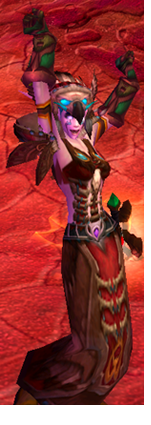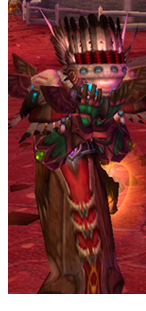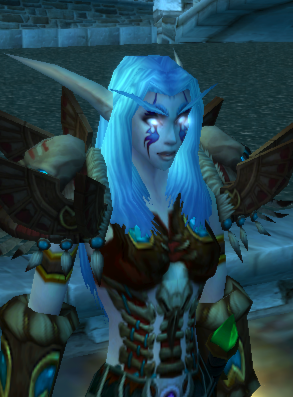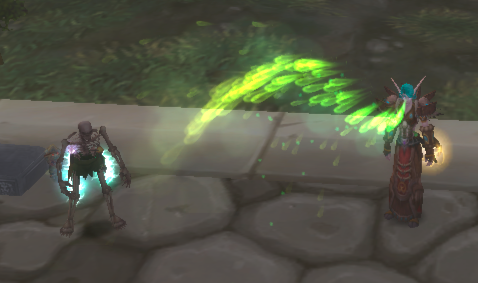
Less than two weeks out from the Wrath of the Lich King release, I find that one of the upcoming changes I am most excited about will hit not with the expansion itself, but with an upcoming content patch. At some future point, many of us–particularly hybrid classes–will have the flexibility we’ve always dreamed of. The promise is that each character will be able to maintain two stored specs and switch between them easily. You won’t be switching during combat (imagine the exploits) but in a complicated dungeon, for one fight you could be the healer, and the very next you could be the tank or even (gasp!) dps.
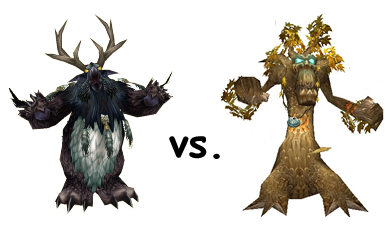
There is every chance that this change will revolutionize gameplay, particularly for healers. Most of us would jump at the chance to heal for a 25-person raid and then tear through our daily quests as a long-feathered, wide-hipped, booty-shaking, snuffle-hooting Owlbeast. I know I would. However, I’m even more interested in the long-term effects of dual spec capability on the raid environment.
Of course, even with Matticus’ fascinating insights into raiding Naxx on the Beta, we still don’t have quite enough information to make fully-fledged (get it, a feather joke) healing strategies. However, that doesn’t mean that my evil little tree-brain isn’t working. As the healing lead for my guild, the following is my diabolical plan to take the fullest possible advantage of dual specs.
1. All healers will maintain a raid-viable dps spec and a raid-viable healing spec.
2. All healers will take appropriate dps gear at the off-spec dkp price and appropriate healing gear at the on-spec price.
3. All healers will practice both play styles in a raid environment.
Why is this plan such a winner? Read on to find out how the dual spec system will save your raid–and the world!–from much weeping and gnashing of teeth.
1. I can adjust the number of healers for each fight.
Based on what I’ve read on Matticus and elsewhere, it seems that Wrath of the Lich King raid encounters require, on the whole, less healers than Black Temple or Sunwell. My guild–and probably many others–recruited its healing corps with the latter two instances in mind. At the moment, we have at least 12 healers who raid on a semi-regular basis. Our healer retention has been excellent, and many of these players have switched part or full-time to alts for raiding in order to keep their spots. However, even with this partial solution, we sometimes have 10 great healers sign up to raid. My solution for Wrath? I’m not about to force people to respec dps or to reroll warlocks and enhancement shammies. Instead, we’ll share the dps and healing roles, and everyone will get to play what they want at least some of the time. In addition, I don’t fully trust the developers not to put in some fights that require 5 healers and others that require 8 in the same instance. With dual specs in place, it will just be too tempting.
2. My healers will become better players.
Yes, this belongs to the category of what I like to refer to as “L2P Raiding Solutions.” It’s going to be hard to switch from doing what Ghostcrawler referred to as “playing the UI, not the game,” to actually targeting a boss or, even more incredibly, assisting off a designated player. I look forward to this process. I need to go through the learning as much or more than anybody. An expansion, as I see it, is a great opportunity to get better at the game, and I know there’s going to be a learning curve. By, let’s say, next February, I want to be that player that people trust to do whichever task, dps or healing, is most necessary. Those players already exist, but I’ve had too much tunnel-vision to be one myself.
3. No one will feel stuck.
Sometimes all of us need a little change, a little breath of fresh air. I think that dual specs are going to help ward off healer burnout, and to demonstrate that, I’m going to resort to a very mundane metaphor. Let’s compare two real life humans–Level 30 Scholars, let’s say, and for the sake of argument, we’ll call them Sydera and Briolante. Now, Syd owns about 10 pairs of shoes she can wear to work, and she never wears the same pair twice in a row. Brio wears the same pair of admittedly very nice dress shoes every day. At the end of six months, whose footwear is in better shape? Variety is the spice of many things, my friends. If I know that I can cast gigantic Starfires on one of the bosses on a given evening, all the while hooting to myself in owlish glee, I’m likely to heal for the rest of them with good grace. Many healers feel victimized and put upon–our job is rather stressful, and blame sticks to us like cat hair on cashmere. What a nice relief it will be to sometimes focus on the boss instead of the little boxes on my Grid!
Dual Specs are Wonderful! But Why Do We Have Them?
I’d like to spend a few moments speculating about the underlying reasoning behind the dual spec change. It goes against many of the trends laid in place during Classic WoW and BC. First, WoW has always made players pay for flexibility. As we all know, the Vanilla WoW design for hybrids could be summed up by the hackneyed refrain “jack of all trades and master of none.” Moreover, gold costs for respecs–used more by hybrids than other classes–used to climb to obscene levels in Classic.
In BC, the fate of hybrids improved somewhat. Aside from a few broken specs (notably Moonkin and Retribution Paladin), hybrids became raid viable, but also just as limited to one role as any “pure” class. Respecs were of course possible, and in BC they top out at 50 gold, which still cannot be considered a reasonable price for mid-raid respecs.
Maybe it’s my own selfish featherbrain, but I think that the changes we’re seeing to how respeccing works–which is basically the removal of the penalty for changing your mind–have a lot to do with the perceived fun of playing hybrids–bringing us closer to the jack of all trades model again. I think this change might even have more to do with healers than other classes. We know that, my own freakishly healer-heavy guild aside, healers are often in short supply. For Wrath, Ghostcrawler has laid out the possibility that raid healing might be overhauled entirely, just as was done with tanking. The idea, in general terms, is to make raiding “more fun.”
What is more fun, in the developers’ minds? Based on the druid class changes for 3.0, I can take a guess. Despite what some healers find entertaining, Blizzard doesn’t want us to be tied too closely to timers or set-in-stone rotations. Pre-3.0, I used to cast something–usually an instant, and many times Lifebloom–every time the GCD was up. This means that I can spare about half an eyeball for the raid environment, and I haven’t even seen many raid bosses. I spend too much time looking at Grid with one eye and the ground–for nasty AoE effects–with the other. To a certain extent, this is necessary for proper focus–I’m not sure that Briolante spends much time gazing longingly on, say, Archimonde’s face either, even though he’s up there tanking. Here’s a quote: “Demon crotches get old after a while.” The developers want play to be variable, engaging, movement heavy, and reactive rather than proactive. As a druid healer at the moment, I feel that I’m supposed to entirely change my playstyle, and old habits–like maintaining Lifebloom rotations–die hard.
At least dual specs are actually fun! Many times, the developers seem to design away from fun by putting arbitrary limitations on things–the recently removed movement speed reduction for trees comes to mind, as does the prohibition on flying in Northrend until level 77. It is my hope that, whatever they do to healing, the dual spec possibility keeps me from entirely losing my mind, or, should I say, my feathers.

